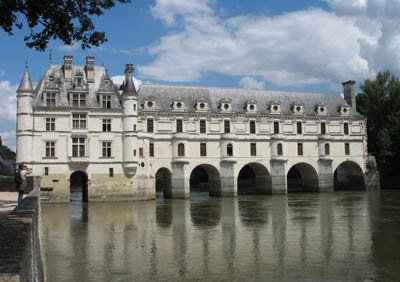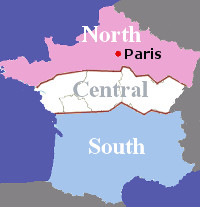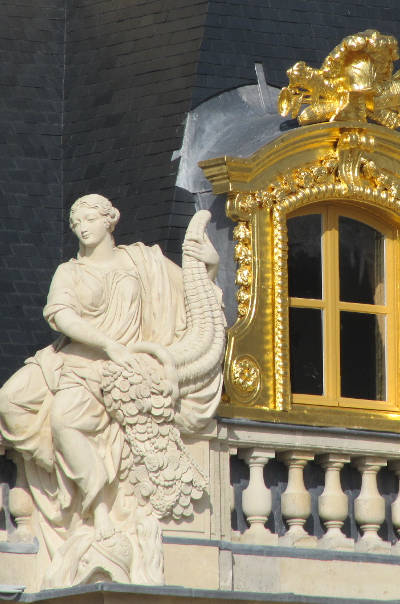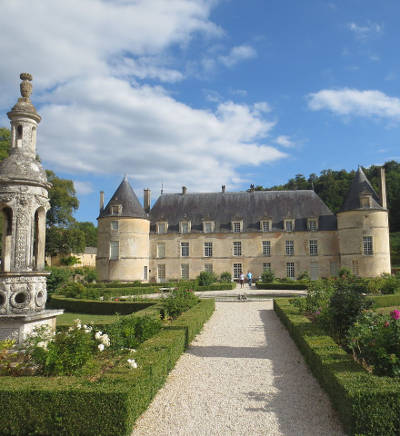
Historic Châteaux in France
France -
The land of 6,000 castles
- Explore France ►
- Essential pages
- Travel in France
- Where to go
- What to see and do
| On this page ► | France of 6000 châteaux | A selection of great historic châteaux |
The area lists below include a pick of the finest châteaux in the north, the midddle and the south of France, with essential information about opening times.
For medieval castles see ► fortresses
This page does not include19th century châteaux and châteaux such as Chantilly or Pierrefonds in the Oise or Hautefort in the Dordogne, that were extensively rebuilt and/or embellished in the nineteenth or twentieth century.
The word "château" covers everything from medieval dungeons and fortresses to the country houses that grace many wine estates. This page presents a choice of the finest French châteaux, including some that are less well known
Stay in a Renaissance château?
A fair number of privately-owned French châteaux offer B&B or hotel-style accommodation. Here is a small selection of some of the most historic and attractive.Loire valley:
between Blois and Tours.
Hotel
Château de Pray - Near Amboise in the Loire valley
- a
Renaissance château with 19 rooms and Michelin listed
restaurant.
Valley of the
Cher: south of Cheverny
Château
de Chémery B&B - Experience the intimacy
of a small
Loire valley Renaissance château. Five suites in
this small
moated château.
Loire valley: near Chinon Hotel Château de Marçay - stay in a genuine 15th century Loire château. Four star. 22 rooms. gourmet restaurant.
Sarthe: near le
Mans
Hotel
Château de la Barre - Just five suites in this
fabulous
Renaissance château, owned by the de Vanssay family for over
6
centuries. 100 acres or gardens.
Charentes
- Hotel
Chateau de Mirambeau
Five-star luxury hotel with Michelin starred restaurant in a
Renaissance chateau north of Cognac.
France's historic monuments agency lists 6,450 châteaux or manor houses, 900 of them owned by the state, the rest in private hands, many of them owned by families that have lived in them for generations. Some are big, some are relatively small.
Even excluding the smaller family residences that call themselves châteaux, there are over 1,000 châteaux in France, many of them visitable; yet unfortunately, or maybe fortunately, most tourist websites and package tours concentrate on a small number of classic châteaux, such as the main ► Loire valley châteaux, or ► Mont Saint Michel in Normandy; and while they are definitely worth visiting, these gems of France's historic heritage get overrun by visitors for much of the year.
For a better visitor experience, it is well worth looking out some of the hundreds more visitable historic châteaux that France has to offer - on or off the beaten track.
The lists below present some thirty of the best French châteaux, several of which are largely unknown outside their region. As for smaller châteaux, the only way to find out which can be visited, and when, is to check out local tourist offices (or their websites), as these may be the only sources of detailed and accurate information for their area. Large tourist offices and web guides tend to prioritize those châteaux that are alredy well-known, often ignoring the less important monuments, particularly those that are privately owned.
French châteaux : the great regions and the great ages

Chenonceau - one of the most visited Loire châteaux.
Regions that saw centuries of strife and conflict in the Middle Ages tend to be rich in historic fortified castles (see ► medieval fortresses).; other areas have a fine choice of peacetime châteaux, built as royal or noble residences when times were good. In other areas, visitors can discover large numbers of châteaux built in the eighteenth or nineteenth centuries by prosperous merchants or landowners.
The finest of France's historic châteaux date from the ► Renaissance (15th century) to the "Grand siècle", the 17th century. The areas with the largest concentration of spectacular Renaissance and grand-siècle châteaux are the parts of France that were at the time both prosperous agricultural areas and in relatively easy striking distance of Paris. The Châteaux of the Loire indeed make up the finest group of Renaissance castles or palaces anywhere in Europe; but they are not the only such castles that France has to offer.
To the southeast of Paris, Burgundy is another area with plenty of châteaux to visit - from fine late gothic castles to neo-classical châteaux of the seventeenth and eighteenth centuries .
The French call the 17th Century "le grand siècle" - the great century. This was the time when France was a great European power, and French culture was at its zenith. It was the golden age of kings Louis XIII and Louis XIV. It was the age of great French architects, thinkers, philosophers and writers. It was the baroque age; but baroque in France was not the ornate florid baroque of Italy or Germany; it was ebullient, but more classical. It was the start of neoclassisism, a style that grew out of the Renaissance's rediscovery of classical art and architecture. And as far as châteaux go, it was the age that saw the building of some of the most iconic of French châteaux, fine châteaux that never had any military signification, but were stately homes, an expression of their owners' prestige.
The greatest of the châteaux of the Grand Siècle is of course the Château de Versailles, Louis XIV's great royal residence ten miles to the west of Paris, which immediately became the benchmark whereby kings and princes all over Europe set their architectural standards.
Versailles was never remotely matched in grandeur, at least not in France; but the 17th and 18th centuries saw the building of many very fine smaller châteaux all over France, châteaux that came to define the paradigm of the French château until the twentieth century.
A pick of the finest historic châteaux in France
 Chateaux
in Northern
France - Paris area and further north
Chateaux
in Northern
France - Paris area and further north
- Château de Versailles, Louis XIV's great royal residence ten miles to the west of Paris. Open all year
- The Château de Fontainebleau, south of Paris - The royal château of King François 1. A magnificent Renaissance rebuilding of an older château. Open all year.
- The Château of Ecouen, 20 km north of Paris. A fine Renaissance château, housing the French national museum of the Renaissance. Open all year.
- The château of Vaux le Vicomte, near Melun, 50 km southeast of Paris, with its classic symmetry and its great gardens à la française, was the model that inspired many other French baroque chateaux large and small.
- The Château d'Anet, west of Paris, near Dreux, right in the north of the Centre -Val de Loire. This Renaissance chateau was the residence of Diane de Poitiers. Privately owned. Open February to November.
- The Chateau de Josselin, in Morbihan, Brittany. On the base of an impressive medieval fortress, with towers, this late gothic / early Renaissance castle is one of the most impressive historic sites in Brittany. It was thoroughly restored in the 18th century. Guided tours.
- The Château d'Etelan, near Rouen in Normandy; a delightful small Renaissance/gothic chateau. Open June to September
- The Château de Fontaine Henry : Normandy - between Caen and the coast. Privately owned, and in the same family since the Middle Ages. Open from spring to autumn.
- The Chateau de Fléville - on the outskirts of Nancy, in Lorraine . Reputedly the finest Renaissance castle in the east of France, one of the few major châteaux in this part of France that escaped demolition after the Thirty Years War. Essentially 16th century. Open from mid-April.
- The château de Haroué, in Lorraine, south of Nancy. A substantial privately owned classic French castle, partly surrounded by a moat. Open weekends June to August, and daily from mid July to mid-August.
Chateaux in central France - from the Loire valley to Burgundy
- The Renaissance châteaux of the Loire (See Châteaux of the Loire) and Touraine. The most famous and most visited Renaissance châteaux in France - though some, like Chambord and Chenonceaux, are far more visited than others.
- Among the Loire valley châteaux, Cheverny, southwest of Orleans, is the greatest classic château dating essentially from the seventeenth century.
- The 16th century castle of Azay-le-Rideau, between Tours and Saumur (See Châteaux of the Loire), is one of the best and most stunning Renaissance castles in Europe
- The Renaissance château de Montgeoffroy stands to the east of Angers in the Pays de la Loire region. It is open every day in July and August, and otherwise from Wednesday to Sunday from March to October. Privately owned.
- The Château d'Ainay le Vieil - Slap in the middle of France, south of Saint Amand Montrond, region Centre -Val de Loire. A delightful small Renaissance chateau built within the fortifications of a medieval fortress, surrounded by a moat. Privately owned - in the same family for over 5 centuries. Open March to mid November.
- The Château de Meillant, also in the far south of the Centre -Val de Loire. A decidedly beautiful late gothic /early Renaissance castle, with ornate tapestries and painted ceilings, open daily from March to 16th November
- The Chateau de Bussy-Rabutin. A beautiful 14th - 16th century moated château in the hills to the west of Dijon in Burgundy. Open all year except 1st January
- The Château
d'Ancy le Franc. East of Auxerre, in Burgundy, is a fine
Italianate Renaissance chateau . Privately owned. The interior
contains the largest collection of Renaissance murals and ceiling
decorations in France. Open late March to mid November.
- The Château de St Fargeau. in the north of Burgundy, is a large 15th - 17th century château. Privately owned. From mid-July to mid-August, this château provides evening visits with historic reenactments; Fridays and Saturdays there is a large historic son et lumère event.
- The Château de Cormatin, in Burgundy. A fine neoclassical château standing in beautiful grounds and surrounded by a moat. Richly decorated interiors, including the "golden rooms". Open daily April to mid-November.
Fine châteaux in Southern France
- The château de Lapalisse, or La Palice. East of Vichy, in Auvergne, this is an imposing 16th - 16th century château standing on a bluff above the river Besbre and the village of Lapalisse. The interior has historic tapestries and a unique 16th century "salon doré" with gilded ceiling.
- The Château de Panloy, near Saintes in the Charentes, was built in 1760 and has belonged to the same family ever since.. coming unscathed through the French Revolution. Its interior furnishings are completely authentic. Open April to 1st November.
- The Château de Milandes is one of a number of attractive small châteaux in the Dordogne. Privately owned. Open daily end March to mid November and during winter holidays.
- The Château de Montbazillac, southern Dordogne. Built in the middle of the 16th century, this is one of the finest French wine estate châteaux. The interior does not have a lot of historic interest, but the location is superb. Owned by the local wine-growers cooperative. Free wine tasting included.
- The Chateau de Lareole - 40 km northwest of Toulouse, in the Midi-Pyrenees area of Occitanie. A striking late Renaissance chateau begun in 1589.
- The Chateau de Merville - 25 km northwest of Toulouse, in the Midi-Pyrenees area of Occitanie. A classic French château built in the style of the southwest. Visits of the château daily in the afternoon July and August.. At other times, check it out.
- The Château de Lourmarin, north of Aix en Provence. the oldest Renaissance chateau in Provence. Belongs to the Louis Vuibert foundation. Open all year
- The Château de la Verdière, in inland Provence, is an impressive 18th century French château built in the Provençal style. A private château open to the public afternoons in July and August, except Mondays
There's more to France than the same old sites that are mentioned in all the tourist guides .....
- Best French towns and cities - the well known and the less well known..
- Beautiful villages in France - an original list of beautiful villages.
- Walled cities in France cities and towns that are still surrounded or largely surrounded by their ancient walls.
- France's great cathedrals
- Wild France rural France and French hill country.

Chateau de Milandes , Dordogne
The best of France
by theme- Prehistoric France
- Roman France - the best sites
- Best medieval cathedrals
- Great medieval fortresses
- Renaissance and classic châteaux
- Loire
valley châteaux
- The best art galleries and museums in France
- Industrial and transport museums
- Scenic railways and steam railways
- First world war sites and memorials
- The French coast and beaches
- Wine regions of France
- Beautiful villages in France

Gilded opulence at Versailles, near Paris

Renaissance ceiling in the Château de Cormatin, Burgundy

Chateau de Bussy-Rabutin, Burgundy
low-cost car hire in France
All photos copyright About-France.com unless otherwise stated
Photo Chateau of Azay le Rideau by Adamsart
